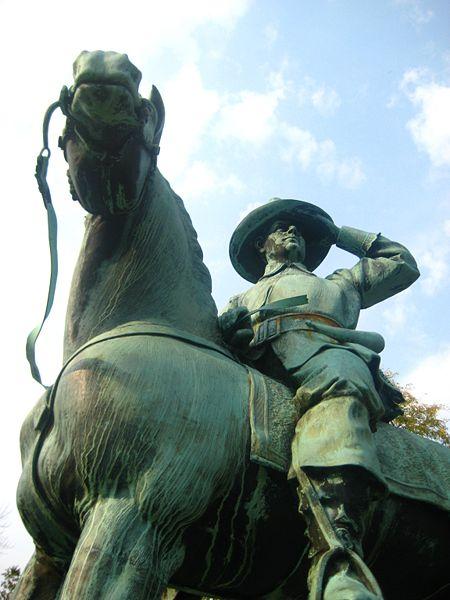Equestrian statue from King William's War and Queen Anne's War
From John Stephen Dwyer, Wikimedia Commons: "Located in Walpole, Massachusetts, United States, this equestrian statue is of early 20th century construction and has a green verdigris patina. The granite base of the monument (which is carved in capital letters) describes the figure as 'LIEUT. LEWIS' and gives dates as 1663 - 1710. He is described as 'OFFICER IN WARS OF KING WILLIAM AND QUEEN ANNE' (i.e. War of Spanish Succession and Queen Anne's War). He is described as a 'TAX COLLECTOR AND SURVEYOR' who 'COVERED FROM 'ROXBURY TO WRENTHAM' and faced such dangers as 'THE PROWLING WOLF'. He is further mentioned the father-in-law of Major Seth Bullard, the uncle of Enoch Ellis and 'ANCESTOR OF A LONG LINE OF DEFENDERS OF THE NATION AND OF WORTHY TEACHERS'. The Lewis family remained prominent in Walpole until the 20th century and the Walpole Historical Society maintains a house once owned by this family."

Dwyer, John Stephen. LieutLewis.jpg. Photograph. Walpole, Massachusetts. October 2008. Accessed June 16, 2023 at https://commons.wikimedia.org/wiki/File:LieutLewis.jpg.
Public Domain
Public Domain is a copyright term that is often used when talking about copyright for creative works. Under U.S. copyright law, individual items that are in the public domain are items that are no longer protected by copyright law. This means that you do not need to request permission to re-use, re-publish or even change a copy of the item. Items enter the public domain under U.S. copyright law for a number of reasons: the original copyright may have expired; the item was created by the U.S. Federal Government or other governmental entity that views the things it creates as in the public domain; the work was never protected by copyright for some other reason related to how it was produced (for example, it was a speech that wasn't written down or recorded); or the work doesn't have enough originality to make it eligible for copyright protection.